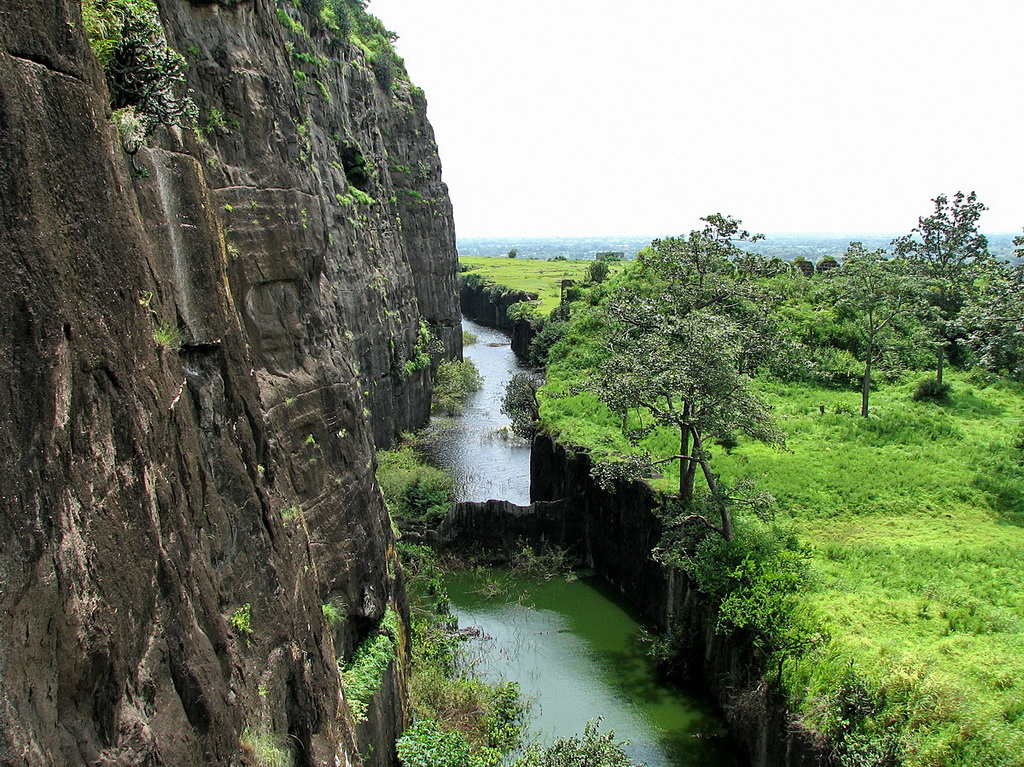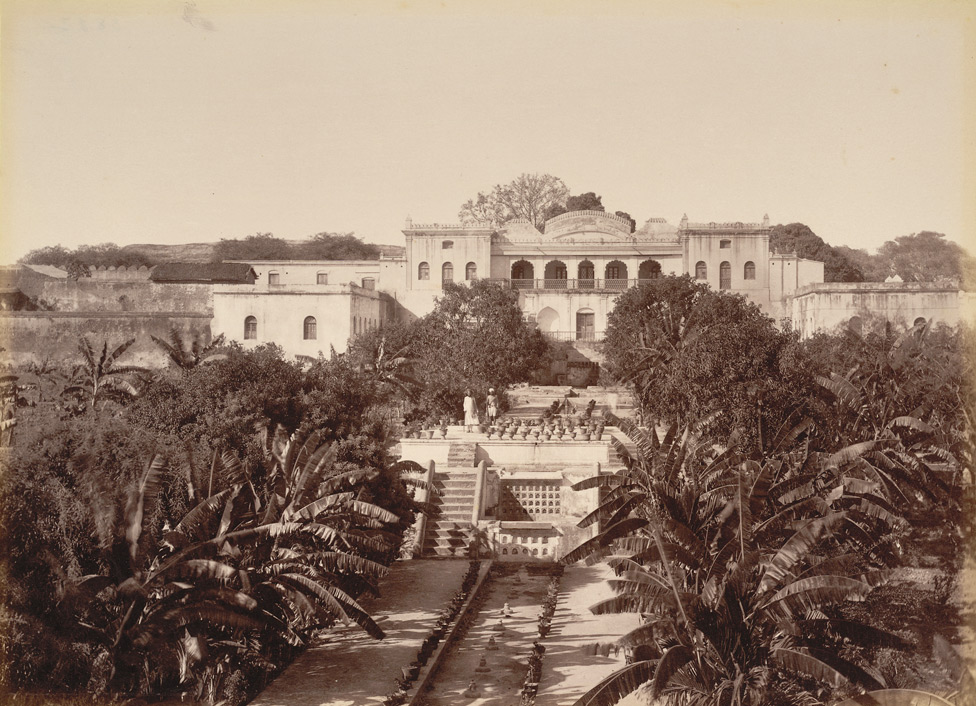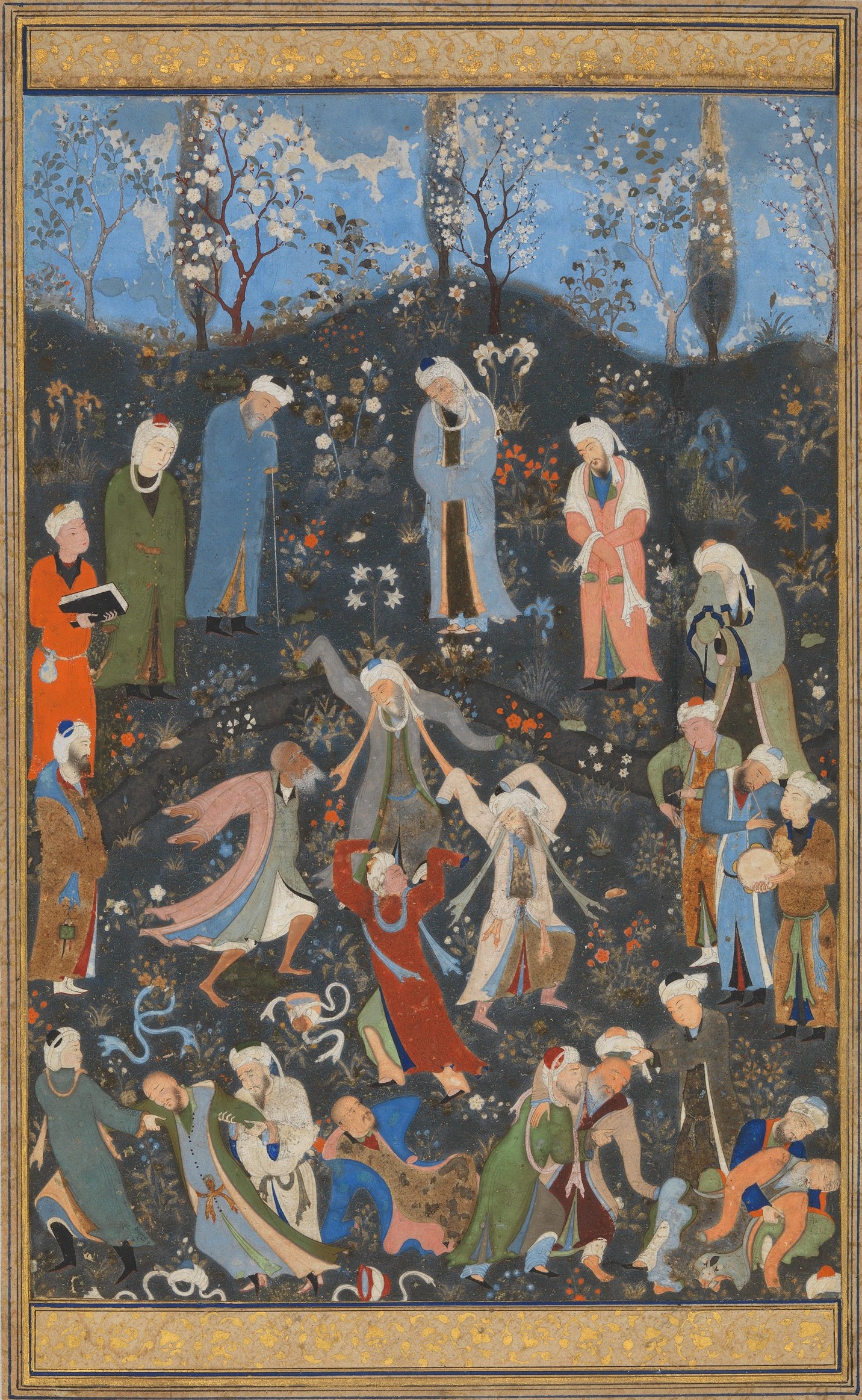|
Ganj Rawan Ganj Baksh
Ganj Rawan Ganj Baksh belonged to the Suhrawardiyya order of Sufi saints, which was founded by Shahab ud din at Baghdad in Hijri 602. He was the earliest of Sufi saint of the Deccan. Ganj Rawan Ganj Baksh Saiad Shah Jalalu-d din or Ganj Rawan Ganj Baksh (which means "moving treasure"), was born at Khirkan near Bukhara, and established the earliest Islamic mission in the Dakhan about Hijri 700, (1300 C.E approx) or a little before the invasion of Alaud din Khalji. He settled down at Unasnagar, between Daulatabad and Roza. Ganj Rawan's tomb at Roza has two trees growing near it, one of which is reputed to have grown from a staff given him by his preceptor, and the other from a branch of the first. Both are said to possess miraculous properties. The mausoleum is to the west of the town. Ganj Rawan Ganj Baksh is believed to be the earliest Mohammedan saint of the district. His dargah has the horse-shoe shaped dome of the Pathans, with piers on the faces supporting pointed arc ... [...More Info...] [...Related Items...] OR: [Wikipedia] [Google] [Baidu] |
Suhrawardiyya
The Suhrawardiyya ( ar, سهروردية, fa, سهروردیه) is a Sufi order founded by Abu al-Najib Suhrawardi (died 1168). Lacking a centralised structure, it eventually divided into various branches. The order was especially prominent in India. The ideology of the Suhrawardiyya was inspired by Junayd of Baghdad (died 910) a Persian scholar and mystic from Baghdad. Under the Ilkhanate (1256–1335), the Suhrawardiyya was one of the three leading Sufi orders, and was based in western Iran. The order had its own '' khanaqahs'' (Sufi lodges), which helped them spread their influence throughout Persianate culture and society. The order included prominent members such as the Akbarian mystics Abd al-Razzaq Kashani (died 1329) and Sa'id al-Din Farghani (died 1300), and the Persian poet Saadi Shirazi Saadi Shīrāzī ( fa, ابومحمّد مصلحالدین بن عبدالله شیرازی), better known by his pen name Saadi (; fa, سعدی, , ), also known as Sadi of Shi ... [...More Info...] [...Related Items...] OR: [Wikipedia] [Google] [Baidu] |
Sufi
Sufism ( ar, ''aṣ-ṣūfiyya''), also known as Tasawwuf ( ''at-taṣawwuf''), is a mystic body of religious practice, found mainly within Sunni Islam but also within Shia Islam, which is characterized by a focus on Islamic spirituality, ritualism, asceticism and esotericism. It has been variously defined as "Islamic mysticism",Martin Lings, ''What is Sufism?'' (Lahore: Suhail Academy, 2005; first imp. 1983, second imp. 1999), p.15 "the mystical expression of Islamic faith", "the inward dimension of Islam", "the phenomenon of mysticism within Islam", the "main manifestation and the most important and central crystallization" of mystical practice in Islam, and "the interiorization and intensification of Islamic faith and practice". Practitioners of Sufism are referred to as "Sufis" (from , ), and historically typically belonged to "orders" known as (pl. ) – congregations formed around a grand who would be the last in a chain of successive teachers linking back to Muha ... [...More Info...] [...Related Items...] OR: [Wikipedia] [Google] [Baidu] |
Shahab Al-Din Suhrawardi
"Shihāb ad-Dīn" Yahya ibn Habash Suhrawardī ( fa, شهابالدین سهروردی, also known as Sohrevardi) (1154–1191) was a PersianEdward Craig, Routledge Encyclopedia of Philosophy, "al-Suhrawardi, Shihab al-Din Yahya (1154-91)" Routledge 1998. Excerpt: "Shihab al-Din Yahya ibn Habash ibn Amirak Abu’l-Futuh al-Suhrawardi, known as al-Maqtul (the Slain One) in reference to his execution, and usually referred to as Shaykh al-Ishraq after his school of Illuminationist philosophy (hikmat al-ishraq), was born in AH 549/AD 1154 in the village of Suhraward in northwestern Iran." philosopher and founder of the Iranian school of Illuminationism, an important school in Islamic philosophy. The "light" in his "Philosophy of Illumination" is the source of knowledge. He is referred to by the honorific title ''Shaikh al-ʿIshraq'' "Master of Illumination" and ''Shaikh al-Maqtul'' "the Murdered Master", in reference to his execution for heresy. Mulla Sadra, the Persian sage of the ... [...More Info...] [...Related Items...] OR: [Wikipedia] [Google] [Baidu] |
Islamic Calendar
The Hijri calendar ( ar, ٱلتَّقْوِيم ٱلْهِجْرِيّ, translit=al-taqwīm al-hijrī), also known in English as the Muslim calendar and Islamic calendar, is a lunar calendar consisting of 12 lunar months in a year of 354 or 355 days. It is used to determine the proper days of Islamic holidays and rituals, such as the Ramadan, annual fasting and the annual season for the Hajj, great pilgrimage. In almost all countries where the predominant religion is Islam, the civil calendar is the Gregorian calendar, with Assyrian calendar, Syriac month-names used in the Arabic names of calendar months#Levant and Mesopotamia, Levant and Mesopotamia (Iraq, Syria, Jordan, Lebanon and State of Palestine, Palestine) but the religious calendar is the Hijri one. This calendar enumerates the Hijri era, whose Epoch (reference date), epoch was established as the Islamic New Year in 622 Common Era, CE. During that year, Muhammad and his followers migrated from Mecca to Medina and es ... [...More Info...] [...Related Items...] OR: [Wikipedia] [Google] [Baidu] |
Deccan Plateau
The large Deccan Plateau in southern India is located between the Western Ghats and the Eastern Ghats, and is loosely defined as the peninsular region between these ranges that is south of the Narmada river. To the north, it is bounded by the Satpura and Vindhya Ranges. A rocky terrain marked by boulders, its elevation ranges between , with an average of about .Editors of Encyclopedia Britannica (2014), ''Deccan plateau India''Encyclopaedia Britannica/ref> It is sloping generally eastward. Thus, its principal rivers—the Godavari, Krishna, and Kaveri (Cauvery)—flow eastward from the Western Ghats to the Bay of Bengal. The plateau is drier than the coastal region of southern India and is arid in places. It produced some of the major dynasties in Indian history, including the Pallavas, Satavahana, Vakataka, Chalukya, and Rashtrakuta dynasties, also the Western Chalukya Empire, the Kadambas, the Yadava dynasty, the Kakatiya Empire, the Musunuri Nayakas regime, the Vijayana ... [...More Info...] [...Related Items...] OR: [Wikipedia] [Google] [Baidu] |
Bukhara
Bukhara (Uzbek language, Uzbek: /, ; tg, Бухоро, ) is the List of cities in Uzbekistan, seventh-largest city in Uzbekistan, with a population of 280,187 , and the capital of Bukhara Region. People have inhabited the region around Bukhara for at least five millennia, and the city has existed for half that time. Located on the Silk Road, the city has long served as a center of trade, scholarship, culture, and religion. The mother tongue of the majority of people of Bukhara is Tajik language, Tajik, a dialect of the Persian language, although Uzbek language, Uzbek is spoken as a second language by most residents. Bukhara served as the capital of the Samanid Empire, Khanate of Bukhara, and Emirate of Bukhara and was the birthplace of scholar Imam Bukhari. The city has been known as "Noble Bukhara" (''Bukhārā-ye sharīf''). Bukhara has about 140 architectural monuments. UNESCO has listed the historic center of Bukhara (which contains numerous mosques and madrasas) as a List o ... [...More Info...] [...Related Items...] OR: [Wikipedia] [Google] [Baidu] |
Alauddin Khalji in the Indian subcontinent. Alauddin instituted a number of significant administrative changes, related to revenue reforms of Alauddin Khalji, revenues, market reforms of Alauddin Khalji, price controls, and rebellions against Alauddin Khalji#Measures for preventing rebellions, society. He also successfully fended off several Mongol invasions of India.
Alauddin was a nephew and a son-in-law of his predecessor Jalal ud din Firuz Khalji, Jalaluddin. When Jalaluddin became the Sultan of Delhi after deposing the Mamluk dynasty (Delhi), Mamluks, Alauddin was give ...
Alaud-Dīn Khaljī, also called Alauddin Khilji or Alauddin Ghilji (), born Ali Gurshasp, was an emperor of the Khalji dynasty that ruled the Delhi Sultanate The Delhi Sultanate was an Islamic empire based in Delhi that stretched over large parts of the Indian subcontinent for 320 years (1206–1526). [...More Info...] [...Related Items...] OR: [Wikipedia] [Google] [Baidu] |
Daulatabad, Maharashtra
Daulatabad Fort, also known as Devagiri Fort or Deogiri Fort, is a historic fortified citadel located in Daulatabad village near Aurangabad, Maharashtra, India. It was the capital of the Yadava dynasty (9th century–14th century CE), for a brief time the capital of the Delhi Sultanate (1327–1334), and later a secondary capital of the Ahmadnagar Sultanate (1499–1636). Around the 6th century CE, Devagiri emerged as an important uplands town near present-day Aurangabad, along caravan routes going towards western and southern India. The historical triangular fortress in the city was initially built around 1187 by the first Yadava king, Bhillama V. In 1308, the city was annexed by Sultan Alauddin Khalji of the Delhi Sultanate, which ruled over most of the Indian subcontinent. In 1327, Sultan Muhammad bin Tughluq of the Delhi Sultanate renamed the city from Devagiri to Daulatabad and shifted his imperial capital to the city from Delhi, ordering a mass migration of Delhi's popula ... [...More Info...] [...Related Items...] OR: [Wikipedia] [Google] [Baidu] |
Khuldabad
Khuldabad () is a city (municipal council) and a Taluka of Aurangabad district in the Indian state of Maharashtra. It is known as the Valley of Saints, or the Abode of Eternity, because in the 14th century, several Sufi saints chose to reside here. The Bhadra Maruti Temple and Dargah of Zar Zari Zar Baksh, Shaikh Burhan ud-din Gharib Chisti and Shaikh Zain-ud-din Shirazi, along with the tomb of the Mughal emperor Aurangzeb and his trusted General Asif Jah I, the first Nizam of Hyderabad, are located in this town. It is a holy and spiritual city of Islamic saints. The place has famous Bhadra Maruti Temple. People come from Aurangabad and nearby places by walk for offering puja on Hanuman Jayanti and on Saturdays in Marathi calendar month "Shravan". Nearby is the Valley of the Saints, which is purported to contain the graves of 1500 Sufi saints. Etymology The name 'Khuldabad' translates to 'Abode of Eternity'. It is derived from the post-humous title of Mughal Emperor ... [...More Info...] [...Related Items...] OR: [Wikipedia] [Google] [Baidu] |
Mohammedan
''Mohammedan'' (also spelled ''Muhammadan'', ''Mahommedan'', ''Mahomedan'' or ''Mahometan'') is a term for a follower of Muhammad, the Islamic prophet. It is used as both a noun and an adjective, meaning belonging or relating to, either Muhammad or the religion, doctrines, institutions and practices that he established. The word was formerly common in usage, but the terms ''Muslim'' and ''Islamic'' are more common today. Though sometimes used stylistically by some Muslims, a vast majority consider the term either archaic or offensive. Etymology The Oxford English Dictionary cites 1663 as the first recorded usage of the English term; the older spelling ''Mahometan'' dates back to at least 1529. The English word is derived from New Latin ''Mahometanus'', from Medieval Latin ''Mahometus'', Muhammad. It meant simply a follower of Mohammad. In Western Europe, down to the 13th century or so, some Christians had the belief that Muhammad had either been a heretical Christian or that ... [...More Info...] [...Related Items...] OR: [Wikipedia] [Google] [Baidu] |
Aurangabad Maharashtra
Aurangabad ( is a city in the Indian state of Maharashtra. It is the administrative headquarters of Aurangabad district and is the largest city in the Marathwada region. Located on a hilly upland terrain in the Deccan Traps, Aurangabad is the fifth-most populous urban area in Maharashtra with a population of 1,175,116. The city is known as a major production center of cotton textile and artistic silk fabrics. Several prominent educational institutions, including Dr. Babasaheb Ambedkar Marathwada University, are located in the city. The city is also a popular tourism hub, with tourist destinations like the Ajanta and Ellora caves lying on its outskirts, both of which have been designated as UNESCO World Heritage Sites since 1983. Other tourist attractions include the Aurangabad Caves, Devagiri Fort, Grishneshwar Temple, Jama Mosque, Bibi Ka Maqbara, Himayat Bagh, Panchakki and Salim Ali Lake. Historically, there were 52 Gates in Aurangabad, some of them extant, because ... [...More Info...] [...Related Items...] OR: [Wikipedia] [Google] [Baidu] |
Sufi Saints Of Aurangabad
Sufism ( ar, ''aṣ-ṣūfiyya''), also known as Tasawwuf ( ''at-taṣawwuf''), is a mystic body of religious practice, found mainly within Sunni Islam but also within Shia Islam, which is characterized by a focus on Islamic spirituality, ritualism, asceticism and esotericism. It has been variously defined as "Islamic mysticism",Martin Lings, ''What is Sufism?'' (Lahore: Suhail Academy, 2005; first imp. 1983, second imp. 1999), p.15 "the mystical expression of Islamic faith", "the inward dimension of Islam", "the phenomenon of mysticism within Islam", the "main manifestation and the most important and central crystallization" of mystical practice in Islam, and "the interiorization and intensification of Islamic faith and practice". Practitioners of Sufism are referred to as "Sufis" (from , ), and historically typically belonged to "orders" known as (pl. ) – congregations formed around a grand who would be the last in a chain of successive teachers linking back to Muh ... [...More Info...] [...Related Items...] OR: [Wikipedia] [Google] [Baidu] |


.jpg)






